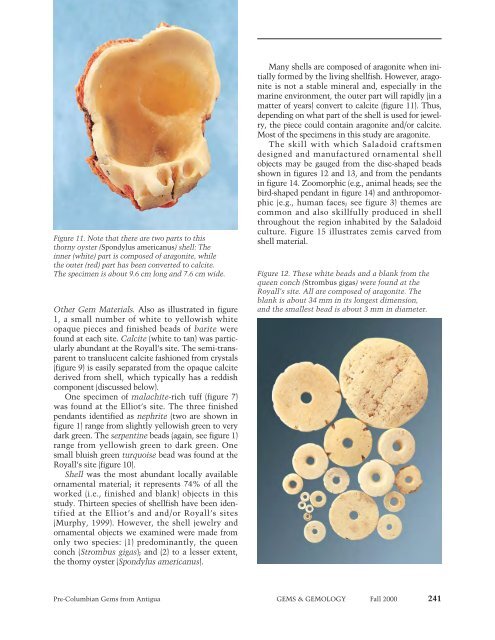Fall 2000 Gems & Gemology - Gemfrance
Fall 2000 Gems & Gemology - Gemfrance
Fall 2000 Gems & Gemology - Gemfrance
Create successful ePaper yourself
Turn your PDF publications into a flip-book with our unique Google optimized e-Paper software.
Figure 11. Note that there are two parts to this<br />
thorny oyster (Spondylus americanus) shell: The<br />
inner (white) part is composed of aragonite, while<br />
the outer (red) part has been converted to calcite.<br />
Other Gem Materials. Also as illustrated in figure<br />
1, a small number of white to yellowish white<br />
opaque pieces and finished beads of barite were<br />
found at each site. Calcite (white to tan) was particularly<br />
abundant at the Royall’s site. The semi-transparent<br />
to translucent calcite fashioned from crystals<br />
(figure 9) is easily separated from the opaque calcite<br />
derived from shell, which typically has a reddish<br />
component (discussed below).<br />
One specimen of malachite-rich tuff (figure 7)<br />
was found at the Elliot’s site. The three finished<br />
pendants identified as nephrite (two are shown in<br />
figure 1) range from slightly yellowish green to very<br />
dark green. The serpentine beads (again, see figure 1)<br />
range from yellowish green to dark green. One<br />
small bluish green turquoise bead was found at the<br />
Royall’s site (figure 10).<br />
Shell was the most abundant locally available<br />
ornamental material; it represents 74% of all the<br />
worked (i.e., finished and blank) objects in this<br />
study. Thirteen species of shellfish have been identified<br />
at the Elliot’s and and/or Royall’s sites<br />
(Murphy, 1999). However, the shell jewelry and<br />
ornamental objects we examined were made from<br />
only two species: (1) predominantly, the queen<br />
conch (Strombus gigas); and (2) to a lesser extent,<br />
the thorny oyster (Spondylus americanus).<br />
Many shells are composed of aragonite when initially<br />
formed by the living shellfish. However, aragonite<br />
is not a stable mineral and, especially in the<br />
marine environment, the outer part will rapidly (in a<br />
matter of years) convert to calcite (figure 11). Thus,<br />
depending on what part of the shell is used for jewelry,<br />
the piece could contain aragonite and/or calcite.<br />
Most of the specimens in this study are aragonite.<br />
The skill with which Saladoid craftsmen<br />
designed and manufactured ornamental shell<br />
objects may be gauged from the disc-shaped beads<br />
shown in figures 12 and 13, and from the pendants<br />
in figure 14. Zoomorphic (e.g., animal heads; see the<br />
bird-shaped pendant in figure 14) and anthropomorphic<br />
(e.g., human faces; see figure 3) themes are<br />
common and also skillfully produced in shell<br />
throughout the region inhabited by the Saladoid<br />
culture. Figure 15 illustrates zemis carved from<br />
shell material.<br />
The specimen is about 9.6 cm long and 7.6 cm wide. Figure 12. These white beads and a blank from the<br />
queen conch (Strombus gigas) were found at the<br />
Royall’s site. All are composed of aragonite. The<br />
blank is about 34 mm in its longest dimension,<br />
and the smallest bead is about 3 mm in diameter.<br />
Pre-Columbian <strong>Gems</strong> from Antigua GEMS & GEMOLOGY <strong>Fall</strong> <strong>2000</strong> 241


